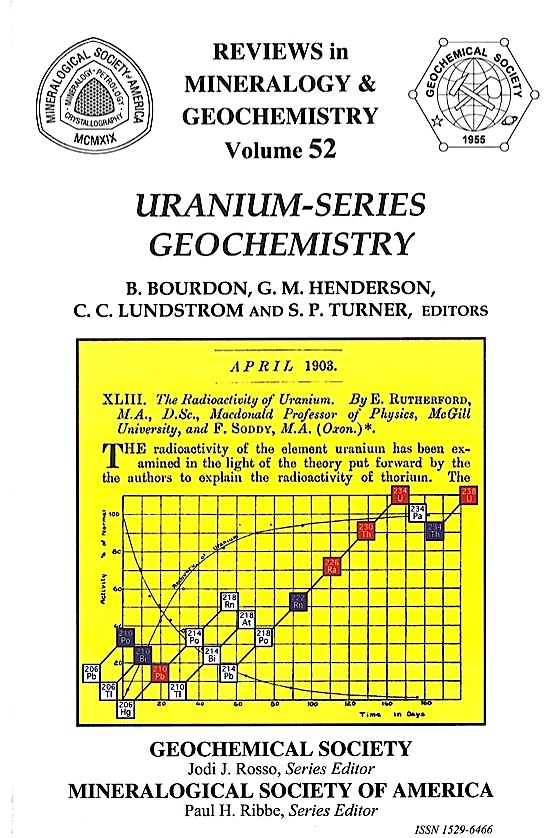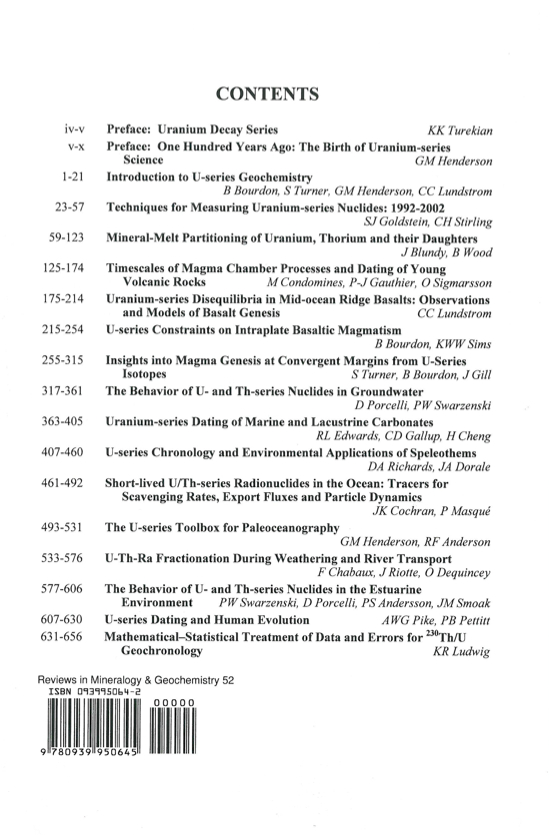

Mineralogical Society of America, Founded December 30, 1919
Order Publications Online (25% discount for MSA, CMS and GS members, except shipping)
MinPubs.org Pay-Per-View GeoScienceWorld Pay-Per-View


2003 i-xx + 656 pages. ISBN 0-939950-64-2; ISBN13 978-0-939950-64-5
Exactly 100 years before the publication of this volume, the first paper which calculated the half-life for the newly discovered radioactive substance U-X (now called 234Th), was published. Now, in this volume, the editors Bernard Bourdon, Gideon Henderson, Craig Lundstrom and Simon Turner have integrated a group of contributors who update our knowledge of U-series geochemistry, offer an opportunity for non-specialists to understand its basic principles, and give us a view of the future of this active field of research. In this volume, for the first time, all the methods for determining the uranium and thorium decay chain nuclides in Earth materials are discussed. It was prepared in advance of a two-day short course (April 3-4, 2003) on U-series geochemistry, jointly sponsored by GS and MSA and presented in Paris, France prior to the joint EGS/AGU/EUG meeting in Nice.
The discovery of the 238U decay chain, of course, started with the seminal work of Marie Curie in identifying and separating 226Ra. Through the work of the Curies and others, all the members of the 238U decay chain were identified. An important milestone for geochronometrists was the discovery of 230Th (called Ionium) by Bertram Boltwood, the Yale scientist who also made the first age determinations on minerals using the U-Pb dating method (Boltwood in 1906 established the antiquity of rocks and even identified a mineral from Sri Lanka-then Ceylon as having an age of 2.1 billion years!)
The application of the 238U decay chain to the dating of deep sea sediments was by Piggott and Urry in 1942 using the "Ionium" method of dating. Actually they measured 222Ra (itself through 222Rn) assuming secular equilibrium had been established between 230Th and 226Ra.
Although 230Th was measured in deep sea sediments by Picciotto and Gilvain in 1954 using photographic emulsions, it was not until alpha spectrometry was developed in the late 1950's that 20Th was routinely measured in marine deposits. Alpha spectrometry and gamma spectrometry became the work horses for the study of the uranium and thorium decay chains in a variety of Earth materials. These ranged from 222Rn and its daughters in the atmosphere, to the uranium decay chain nuclides in the oceanic water column, and volcanic rocks and many other systems in which either chronometry or element partitioning, were explored.
Much of what we learned about the 238U, 235U and 232Th decay chain nuclides as chronometers and process indicators we owe to these seminal studies based on the measurement of radioactivity.
The discovery that mass spectrometry would soon usurp many of the tasks performed by radioactive counting was in itself serendipitous. It came about because a fundamental issue in cosmochemistry was at stake. Although variation in 235U/238U had been reported for meteorites the results were easily discredited as due to analytical difficulties. One set of results, however, was published by a credible laboratory long involved in quality measurements of high mass isotopes such as the lead isotopes. The purported discovery of 235U/238U variations in meteorites, if true, would have consequences in defining the early history of the formation of the elements and the development of inhomogeneity of uranium isotopes in the accumulation of the protoplanetary materials of the Solar System.
Clearly the result was too important to escape the scrutiny of falsification implicit in the way we do science. The Lunatic Asylum at Caltech under the leadership of Jerry Wasserburg took on that task. Jerry Wasserburg and Jim Chen clearly established the constancy and Earth-likeness of 235U/238U in the samplable universe. In the hands of another member of the Lunatic Asylum, Larry Edwards, the methodology was transformed into a tool for the study of the 238U decay chain in marine systems. Thus the mass spectrometric techniques developed provided an approach to measuring the U and Th isotopes in geological materials as well as cosmic materials with the same refinement and accommodation for small sample size.
Soon after this discovery the harnessing of the technique to the measurement of all the U isotopes and all the Th isotopes with great precision immediately opened up the entire field of uranium and thorium decay chain studies. This area of study was formerly the poaching ground for radioactive measurements alone but now became part of the wonderful world of mass spectrometric measurements. (The same transformation took place for radiocarbon from the various radioactive counting schemes to 'accelerator mass spectrometry.)
No Earth material was protected from this assault. The refinement of dating corals, analyzing volcanic rocks for partitioning and chronometer studies and extensions far and wide into ground waters and ocean bottom dwelling organisms has been the consequence of this innovation.
Although Ra isotopes, 210Pb and 210Po remain an active pursuit of those doing radioactive measurements, many of these nuclides have also become subject to the mass spectrometric approach.
In this volume, for the first time, all the methods for determining the uranium and thorium decay chain nuclides in Earth materials are discussed. The range of problems solvable with this approach is remarkable-a fitting, tribute to the Curies and the early workers who discovered them for us to use.
September 2003
Dedication
Inside Front Cover
Title Page
p. i
Copyright
p. ii
Foreword & Acknowledgments
p. iii
Preface
p. iv - x
Table of Contents
p. xi - xx
Chapter 1. Introduction to U-series Geochemistry
by Bernard Bourdon, Simon Turner, Gideon M. Henderson and Craig C. Lundstrom, p. 1 - 22
Chapter 2. Techniques for Measuring Uranium-series Nuclides: 1992-2002
by Steven J. Goldstein and Claudine H. Stirling, p. 23 - 58
Chapter 3. Mineral-Melt Partitioning of Uranium, Thorium and Their Daughters
by Jonathan Blundy and Bernard Wood, p. 59 - 124
Chapter 4. Timescales of Magma Chamber Processes and Dating of Young Volcanic Rocks
by Michel Condomines, Pierre-Jean Gauthier, and Olgeir Sigmarsson, p. 125 - 174
Chapter 5. Uranium-series Disequilibria in Mid-ocean Ridge Basalts: Observations and Models of Basalt Genesis
by Craig C. Lundstrom, p. 175 - 214
Chapter 6. U-series Constraints on Intraplate Basaltic Magmatism
by Bernard Bourdon and Kenneth W. W. Sims, p. 215 - 254
Chapter 7. Insights into Magma Genesis at Convergent Margins from U-series Isotopes
by Simon Turner, Bernard Bourdon and Jim Gill, p. 255 - 316
Chapter 8. The Behavior of U- and Th-series Nuclides in Groundwater
by Donald Porcelli and Peter W. Swarzenski, p. 317 - 362
Chapter 9. Uranium-series Dating of Marine and Lacustrine Carbonates
by R. L. Edwards, C. D. Gallup, and H. Cheng, p. 363 - 406
Chapter 10. Uranium-series Chronology and Environmental Applications of Speleothems
by David A. Richards and Jeffrey A. Dorale, p. 407 - 460
Errata for Chapter 10 pdf or html
Chapter 11. Short-lived U/Th Series Radionuclides in the Ocean: Tracers for Scavenging Rates, Export Fluxes and Particle Dynamics
by J. K. Cochran and P. Masquè, p. 461 - 492
Chapter 12. The U-series Toolbox for Paleoceanography
by Gideon M. Henderson and Robert F. Anderson, p. 493 - 532
Chapter 13. U-Th-Ra Fractionation During Weathering and River Transport
by F. Chabaux, J. Riotte and O. Dequincey, p. 533 - 576
Chapter 14. The Behavior of U- and Th-series Nuclides in the Estuarine Environment
by Peter W. Swarzenski, Donald Porcelli, Per S. Andersson and Joseph M. Smoakv, p. 577 - 606
Chapter 15. U-series Dating and Human Evolution
by A. W. G. Pike and P. B. Pettitt, p. 607 - 630
Chapter 16. Mathematical-Statistical Treatment of Data and Errors for 230Th/U Geochronology
by K. R. Ludwig, p. 631 - 656